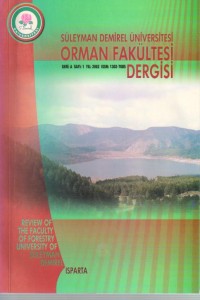Abstract
The goal of this study is to determine the effects of various timber preservers on bending strength (BS), modulus of elasticity (MOE) and internal bond (IB) of particleboard, and whether the levels of those of effecs are importance or not
The following material were used for manufacturing of experimental boars; wood chips, urea-formaldehyde and various wood preservers. The urea-formaldehyde were utilized according to the ovendry weight of the chips, the other chemicals were treated as to the ovendry weight of the adhesive. The chips were impregnated with solutions of the preservers in the gluing machine before adhering treatment. The boards were manufactured by pressing at temperature 150°C and pressure 25–28 kp/cm2.
As a result; the mechanical properties of the board have increased with increasing of using amounts of impregnating substances. According to the control, the rates of increase have ranged from 2.01% to 34.93% for BS, from 2.67% to 49.18% for MOE, and from 0.50% to 42.13% for IB. For BS and MOE, while this increase is unimportant statistically in the boards impregnated with pine rosin, alcid resin and immersol WR, it is important in the other boards. For IB, the increase has not significance in the boards treated with boric acid/borax, tanalith CBC and tanalith CBC/boric acid/borax, whereas it has significance in the others.
Keywords: Impregnation, Industrial wood chips, Particleboard, Mechanical properties.
Keywords
Abstract
Bu çalışmanın amacı; çeşitli emprenye maddelerinin yongalevhanın eğilme direnci (ED), elastikiyet modülü (EM) ve levha yüzüne dik çekme direnci (ÇD) üzerine etkilerini ve bu etkilerin önem derecelerini belirlemektir.
Araştırmada; endüstriyel odun yongaları, üre-formaldehit ve çeşitli emprenye maddeleri kullanılmıştır. Üre-formaldehid tam kuru yonga ağırlığına oranla, diğer kimyasallar ise tam kuru tutkal ağırlığına oranla uygulanmıştır. Levhalar, tutkal püskürtme makinasında emprenye edilen yongalar tutkallandıktan sonra, bu yongalar 150°C sıcaklık ve 25–28 kp/cm2 basınçta preslenerek üretilmiştir.
Sonuç olarak; emprenye maddesi kullanım miktarı arttıkça, kontrole göre, ED %2.01–34.93, EM %2.67–49.18 ve ÇD %0.50-42.13 arasında artmıştır. Bu artış, ED ve EM için kolofan, alkid reçinesi, immersol-WR'li levhalarda önemsizken diğerlerinde önemli; ÇD için ise borik asit/boraks, tanalith-CBC, tanalith-CBC/borik asit/borakslı levhalarda anlamsızken diğerlerinde anlamlı bulunmuştur.
Anahtar Kelimeler: Emprenye, Endüstriyel odun yongaları, Yongalevha, Mekanik özellikler
Keywords
Details
| Primary Language | Turkish |
|---|---|
| Journal Section | Orijinal Araştırma Makalesi |
| Authors | |
| Publication Date | February 9, 2009 |
| Published in Issue | Year 2002 Volume: 3 Issue: 1 |


